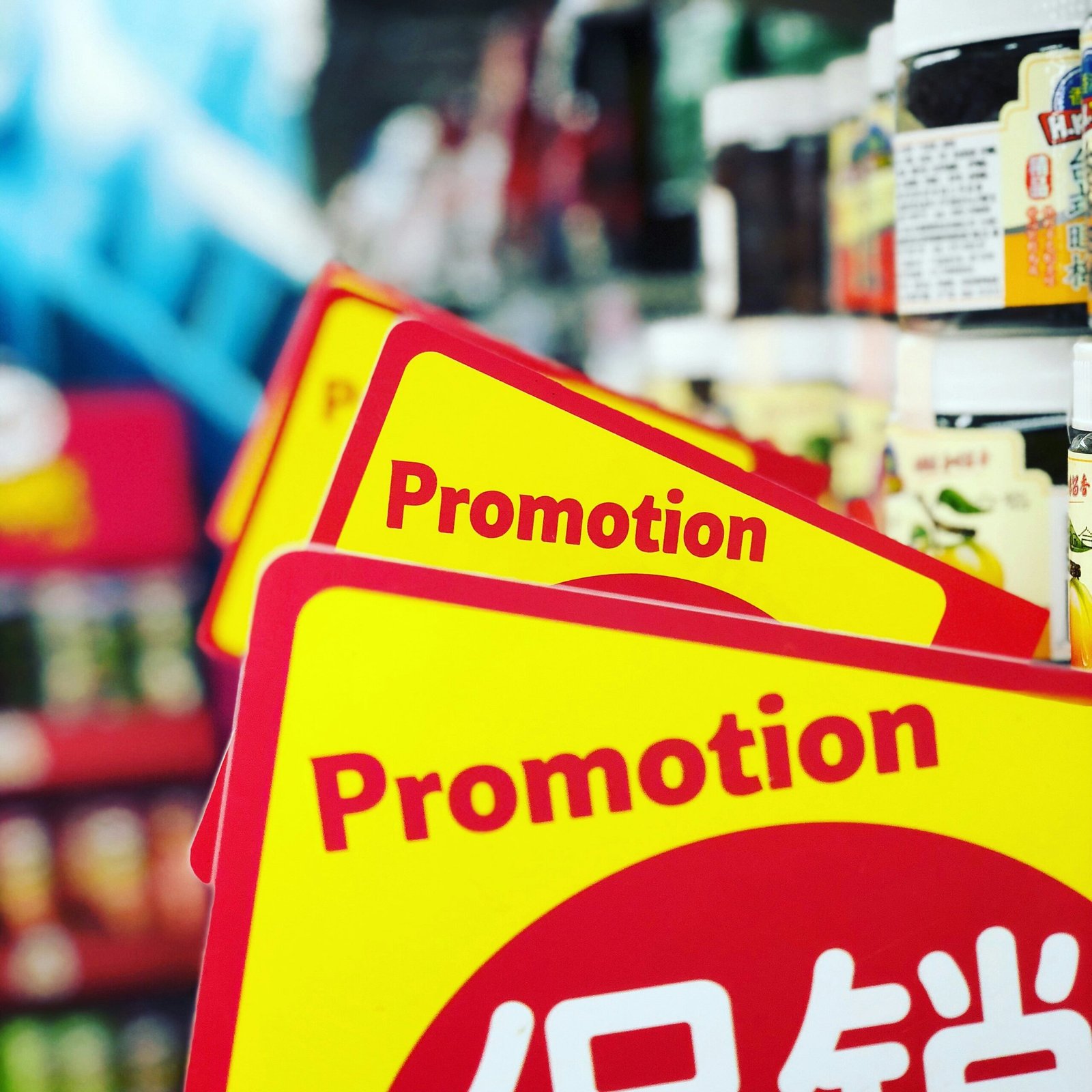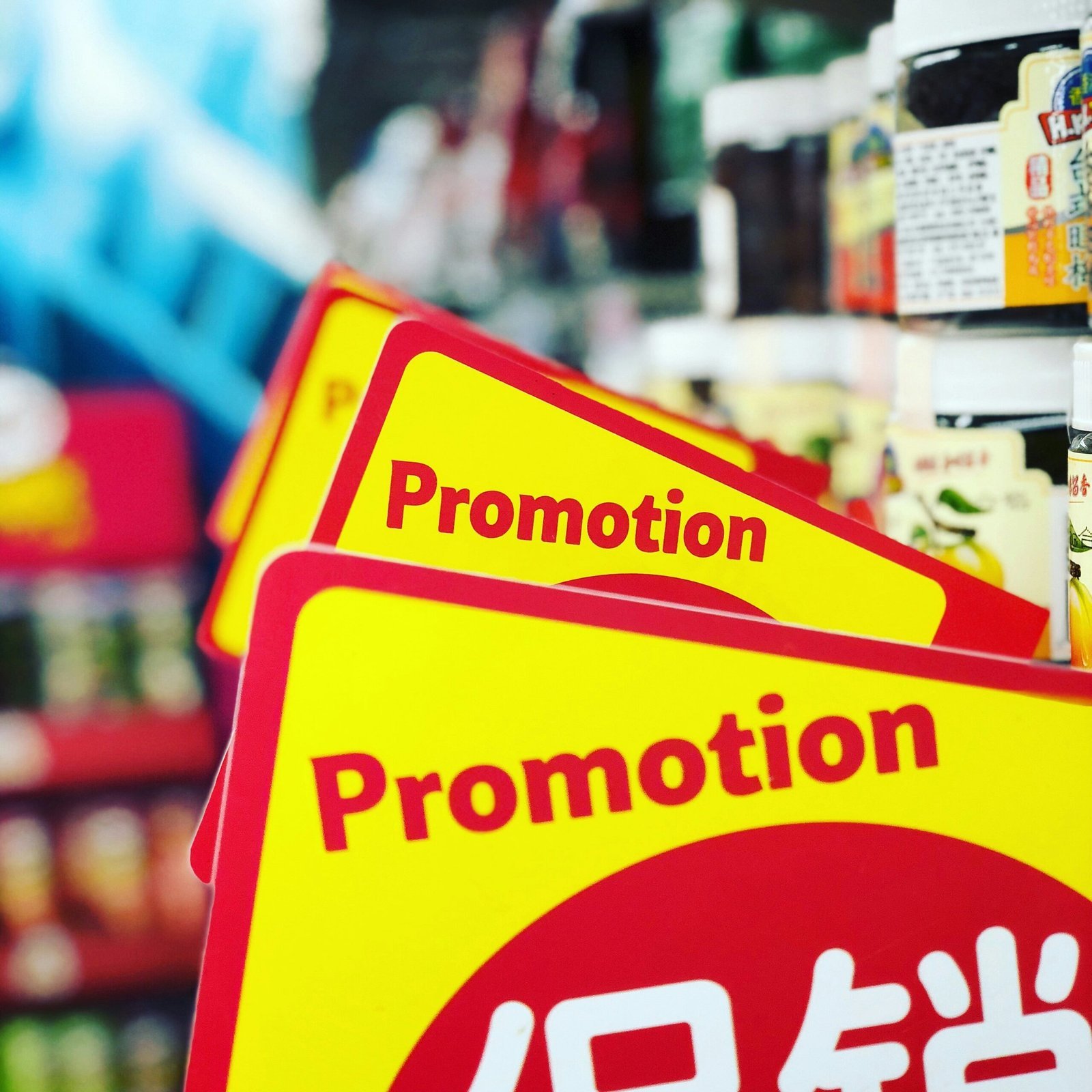
Photo by <a href="https://unsplash.com/@jjying" rel="nofollow">JJ Ying</a> on <a href="https://unsplash.com/?utm_source=hostinger&utm_medium=referral" rel="nofollow">Unsplash</a>

Introduction to Promotional Program Sales
Promotional program sales are strategic initiatives designed to enhance revenue by driving sales, attracting new customers, and retaining existing ones. These programs are vital in the competitive business landscape, where companies continually seek innovative ways to stand out. At their core, promotional programs are crafted to create a compelling value proposition for customers, making products or services more appealing through various incentives.
One of the primary types of promotional programs is discounts. These can be time-limited offers or ongoing deals that reduce the price of a product or service, enticing both new and repeat customers to make a purchase. Discounts can be applied in numerous ways, such as percentage reductions, buy-one-get-one-free offers, or bundled deals, each tailored to target specific customer segments and drive sales volume.
Loyalty programs are another significant category within promotional program sales. These initiatives reward repeat customers with points, discounts, or exclusive offers, fostering a sense of appreciation and encouraging continued patronage. By accumulating rewards over time, customers are more likely to return, thereby increasing their lifetime value to the business.
Special offers, including limited-time promotions, holiday sales, and exclusive member deals, are also crucial in promotional program sales. These offers create urgency and exclusivity, motivating customers to act quickly to take advantage of the deal. Such programs not only boost immediate sales but also help in attracting new customers who might become long-term patrons.
Integrating these various types of promotional programs into a broader marketing strategy is essential for maximizing their effectiveness. Businesses need to carefully plan and execute these initiatives to align with their overall brand messaging and market positioning. When done correctly, promotional program sales can significantly impact a company’s revenue, customer acquisition, and retention efforts, making them a cornerstone of a successful marketing strategy.
Understanding Your Target Audience
Before launching any promotional program, comprehending your target audience is crucial. Effective market research is the foundation of this understanding. Techniques such as surveys, focus groups, and data analytics provide valuable insights into customer demographics, preferences, and purchasing behavior. By leveraging these methods, businesses can tailor their promotional programs to align with the needs and desires of their audience, thereby enhancing sales effectiveness.
Surveys are one of the most straightforward tools for gathering information. They allow businesses to ask specific questions directly to their customers, providing immediate feedback on products, services, and promotional ideas. Online surveys, in particular, offer a cost-effective and efficient way to reach a broad audience.
Focus groups, on the other hand, provide a more in-depth understanding of customer attitudes and behaviors. By engaging a small, diverse group of people in detailed discussions, businesses can gain qualitative insights that might not be apparent through surveys alone. This method is particularly useful for exploring complex issues, such as customer motivations and emotional responses to marketing messages.
Data analytics plays a critical role in understanding purchasing behaviors. By analyzing data from various sources, including sales records, social media interactions, and website traffic, businesses can identify trends and patterns. This information can help predict future behaviors and preferences, allowing companies to design promotional programs that resonate with their target audience.
Understanding customer demographics is also essential. Knowing the age, gender, income level, and geographic location of your audience can help tailor promotional strategies. For example, a promotional program aimed at young adults may focus on social media channels, while one targeting older adults might use more traditional media.
Ultimately, the goal of understanding your target audience is to create promotional programs that are not only appealing but also effective in driving sales. By employing a combination of surveys, focus groups, and data analytics, businesses can gain a comprehensive understanding of their customers, enabling them to craft strategies that meet their needs and maximize revenue.
Setting Clear Goals and Objectives
Defining clear and measurable goals is a foundational step in designing an effective promotional program. Establishing these goals provides direction and benchmarks for success, ensuring that every promotional activity contributes to the broader business objectives. The types of goals you set can significantly impact the focus and outcomes of your promotional program.
Common goals include increasing sales, boosting brand awareness, and enhancing customer loyalty. Increasing sales is often the most immediate objective, aiming to generate higher revenue through targeted promotions. Boosting brand awareness involves making more people aware of your products or services, which can lead to long-term growth. Enhancing customer loyalty focuses on retaining existing customers by fostering stronger relationships, thereby ensuring repeat business.
To set effective goals, it’s crucial to employ the SMART criteria. SMART stands for Specific, Measurable, Achievable, Relevant, and Time-bound. Specific goals provide a clear direction, such as “increasing monthly sales by 10%.” Measurable goals enable you to track progress, ensuring that you can quantify the outcomes. Achievable goals are realistic and attainable, considering your resources and market conditions. Relevant goals align with your broader business objectives, ensuring that your promotional efforts support overall strategy. Lastly, Time-bound goals have a defined timeframe, such as achieving a certain sales increase within six months, which instills a sense of urgency and focus.
Aligning your promotional goals with your overall business objectives ensures coherence and synergy across all marketing activities. For instance, if your business objective is to expand into new markets, your promotional goals might include increasing brand awareness in those regions. By setting clear, SMART goals and aligning them with business objectives, you create a roadmap that guides your promotional efforts towards achieving maximum revenue and long-term business success.
Designing an Effective Promotional Strategy
Creating a compelling promotional strategy is crucial for maximizing revenue. Various promotional tactics can be employed to capture the attention of your target audience and encourage purchases. One effective approach is offering limited-time offers, which create a sense of urgency and can drive immediate sales. These offers can be particularly effective during key shopping periods, such as holidays or end-of-season sales.
Another strategy involves bundle deals, where customers can purchase multiple products at a discounted rate. Bundling not only increases the perceived value of the offer but also encourages customers to buy more than they initially intended. This tactic can be especially beneficial for clearing out slow-moving inventory or introducing new products to the market.
Loyalty rewards are another powerful tool in a promotional strategy. By offering points, discounts, or exclusive access to loyal customers, businesses can foster a sense of appreciation and encourage repeat purchases. A well-structured loyalty program can significantly enhance customer retention and lifetime value.
The effectiveness of any promotional strategy heavily depends on the messaging. Clear, compelling, and consistent messaging is essential to convey the value of the promotion. Tailoring the message to resonate with your target audience can significantly enhance its impact. It’s also crucial to ensure that the promotional message aligns with your brand’s overall voice and values.
Timing plays a pivotal role in the success of promotional programs. Launching promotions during peak shopping periods, or aligning them with significant events or trends, can amplify their effectiveness. Additionally, understanding your audience’s purchasing behavior and preferences can help in timing the promotions for maximum impact.
Choosing the right promotional channels is equally important. Depending on where your target audience spends their time, you can leverage various platforms such as social media, email marketing, or in-store promotions. Each channel has its strengths and can be utilized to reach different segments of your audience effectively.
In conclusion, designing an effective promotional strategy involves a mix of well-thought-out tactics, compelling messaging, strategic timing, and choosing the right channels. By considering these factors, businesses can create promotions that not only attract customers but also drive significant revenue growth.
Leveraging Digital Marketing for Promotions
Digital marketing plays a pivotal role in the success of promotional program sales. With the growing reliance on online platforms, businesses have a plethora of tools at their disposal to reach and engage potential customers. Social media, email marketing, and search engine marketing are among the most effective digital strategies that can be leveraged to enhance the visibility and appeal of promotional programs.
Social media platforms such as Facebook, Instagram, Twitter, and LinkedIn offer businesses the opportunity to connect with a vast audience. Utilizing these platforms, companies can create targeted ads that reach specific demographics. For instance, using Facebook’s advanced targeting options, businesses can focus their promotions on users based on their interests, behaviors, and location. Engaging content, such as eye-catching visuals and interactive posts, can significantly boost user engagement and drive traffic to promotional offers.
Email marketing remains a powerful tool for direct communication with potential customers. By building a robust email list, businesses can send personalized messages and exclusive offers to their subscribers. Effective email marketing campaigns should include compelling subject lines, clear calls-to-action, and visually appealing designs. Additionally, segmenting the email list based on customer preferences and behaviors can ensure that the right message reaches the right audience, thereby increasing the chances of conversion.
Search engine marketing (SEM), including both search engine optimization (SEO) and pay-per-click (PPC) advertising, is essential for increasing the online visibility of promotional programs. By optimizing website content for relevant keywords, businesses can improve their organic search rankings and attract more traffic. PPC campaigns, on the other hand, allow businesses to bid on keywords and display ads to users who are actively searching for related products or services. A well-executed SEM strategy can drive high-quality leads and maximize return on investment.
Best practices for online promotions involve the use of compelling visuals, engaging content, and data-driven targeting. High-quality images and videos can capture the attention of potential customers and make promotional offers more appealing. Crafting engaging content that resonates with the audience and provides value can encourage users to take action. Furthermore, leveraging data analytics to understand customer behavior and preferences can help businesses tailor their promotional strategies for maximum effectiveness.
Monitoring and Analyzing Performance
Tracking and analyzing the performance of your promotional programs is essential for maximizing revenue and ensuring the effectiveness of your marketing efforts. Key performance indicators (KPIs) form the backbone of this analysis, providing quantifiable measures of success and areas for improvement. Among the most critical KPIs are conversion rates, customer acquisition costs (CAC), and return on investment (ROI). Each of these metrics offers unique insights into the efficacy of your promotions and overall marketing strategy.
Conversion rates, for instance, indicate the percentage of visitors who take the desired action, such as making a purchase or signing up for a newsletter. This metric helps assess the attractiveness and persuasiveness of your promotional content. On the other hand, CAC measures the cost associated with acquiring a new customer, offering a clear picture of the financial efficiency of your promotional campaigns. Finally, ROI evaluates the profitability of your promotions by comparing the revenue generated to the costs incurred, providing a comprehensive view of their financial impact.
To effectively monitor these KPIs, leveraging robust data collection and analysis tools is vital. Platforms such as Google Analytics, CRM systems, and bespoke data analytics software can provide real-time insights and advanced reporting capabilities. These tools allow businesses to track user behavior, segment audiences, and measure the performance of different promotional tactics. Techniques such as A/B testing can further enhance your analysis by comparing the effectiveness of various promotional strategies, enabling data-driven decision-making.
Using these insights, businesses can refine and improve future promotions. For example, if data reveals that certain promotional channels yield higher conversion rates but also higher CAC, a strategic shift might be necessary to balance cost and effectiveness. Similarly, an in-depth analysis of ROI across different campaigns can highlight the most profitable initiatives, guiding resource allocation and investment decisions. By continuously monitoring and analyzing performance, businesses can optimize their promotional programs, driving sustained revenue growth and long-term success.
Case Studies of Successful Promotional Programs
To elucidate the impact of well-executed promotional programs, we will examine several case studies that highlight the strategies, challenges, and outcomes of successful enterprises. These real-world examples serve as a blueprint for businesses aiming to enhance their own promotional efforts.
One notable case is that of XYZ Electronics, a mid-sized retailer specializing in consumer electronics. XYZ Electronics launched a promotional campaign centered around seasonal discounts and bundled offers. The strategy involved extensive market research to identify high-demand products and competitive pricing. By leveraging targeted social media advertising and email marketing, XYZ Electronics saw a 30% increase in sales during the promotional period. The key to their success was a well-coordinated marketing effort that resonated with their customer base, coupled with an efficient inventory management system to handle the surge in demand.
Another exemplary case is ABC Apparel, a fashion retailer that implemented a loyalty program aimed at boosting customer retention. The program offered points for purchases, referrals, and social media engagement, which could be redeemed for discounts on future purchases. Despite initial challenges in customer adoption, ABC Apparel used personalized communication to educate customers about the benefits of the loyalty program. Over six months, the company experienced a 25% increase in repeat purchases, significantly enhancing customer lifetime value. The program’s success was largely attributed to its seamless integration with the company’s existing CRM system, enabling precise tracking and rewarding of customer activities.
Lastly, DEF Food & Beverage, a chain of restaurants, utilized a promotional program focused on limited-time offers and exclusive menu items. By collaborating with local influencers and food bloggers, DEF Food & Beverage generated substantial buzz and attracted a new customer segment. The promotional program resulted in a 20% increase in foot traffic and a notable rise in average transaction value. The primary factors contributing to their success included strategic partnerships, compelling content, and an agile approach to menu innovation.
These case studies underscore the importance of strategic planning, customer engagement, and effective use of technology in executing successful promotional programs. Businesses looking to maximize revenue should consider these elements when designing their promotional initiatives.
Conclusion and Next Steps
Throughout this blog post, we have delved into the critical aspects of maximizing revenue through effective promotional program sales. One of the fundamental elements discussed is the importance of understanding your audience. By gaining insights into customer preferences and behaviors, businesses can tailor their promotional programs to meet specific needs, thereby enhancing engagement and conversions.
Setting clear goals is another pivotal step in driving successful promotional strategies. Clear, measurable objectives provide direction and enable businesses to assess the effectiveness of their efforts. Coupled with this, designing an effective strategy that integrates various promotional tactics ensures that the programs resonate with the target audience and achieve desired outcomes.
Leveraging digital marketing is essential in the current business landscape. The utilization of online platforms and tools can significantly amplify the reach and impact of promotional programs. From social media campaigns to email marketing and search engine optimization, digital marketing offers diverse avenues for connecting with potential customers and driving sales.
Monitoring performance is equally crucial. By continuously tracking and analyzing key metrics, businesses can identify what works and what doesn’t, allowing for timely adjustments to optimize results. Performance monitoring ensures that promotional strategies remain dynamic and responsive to market changes and consumer feedback.
As actionable next steps, businesses should start by conducting a thorough audience analysis to inform their promotional strategies. Setting specific, achievable goals will provide a roadmap for success. Crafting a comprehensive strategy that leverages digital marketing channels will enhance visibility and engagement. Finally, implementing a robust performance monitoring system will enable ongoing optimization and sustained revenue growth.
By applying the insights and strategies discussed, businesses can develop and implement effective promotional programs that maximize revenue and drive growth. The journey to successful promotional program sales is continuous, but with the right approach, it is both achievable and rewarding.


